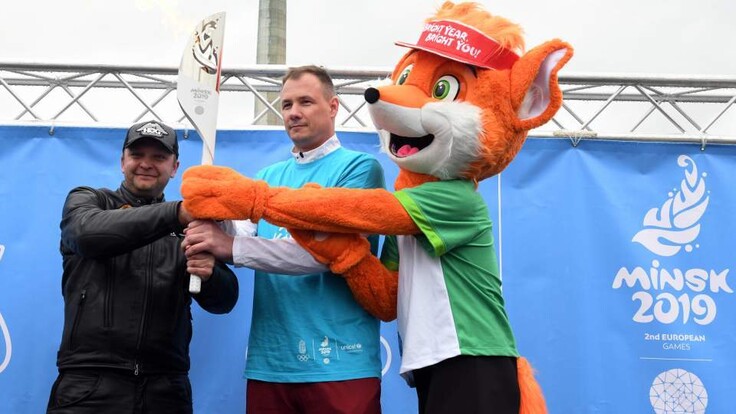The torch of the II. Minsk European Games arrived from Vienna to Budapest on 9 May. The Hungarian Olympic Committee (HOC) organized a relay run including the most beautiful parts of the capital city, 43 days before the start of the games on 21 June.
The HOC celebrated its 124th anniversary this year, thus 124 runners participated in the torch run, including Olympic and Paralympic athletes, sport leaders, artists, public figures and media personalities, sponsors, politicians, doctors and students of Olympic Schools.

The run started from Heroes’ Square and participants were greeted by HOC President Krisztián Kulcsár, Ambassador of Belarus to Budapest Aleksandr Ponomarev and MEGOC Head of Cultural Programmes and Official Ceremonies Sergey Khomich.
Aleksandr Ponomarev was the first to greet the participants and the present members of the European Games’ Organizing Committee. He briefly detailed the torch’s way so far, from Rome through Mont Blanc, Ljubljana and Vienna to Budapest and elaborated that the international holiday of Victory Day is also celebrated on this day, to which the values represented by the European Games and the torch run fit perfectly.
According to Sergey Khomich, this has been the biggest and most beautiful event they have attended throughout the journey of the torch. He emphasized that everybody is welcome to the Games as it is possible to travel visa-free, and cosy accommodations and hospitable locals are waiting for the attendees. Khomich desires for the European Games to follow in the footsteps of the American and Asian Games and for it to become a prestigious tradition.
István Tarlós, Lord Mayor of Budapest, Georg von Habsburg and Tünde Szabó, Secretary of State for Sport were welcomed by Krisztián Kulcsár at the event which was organized on the 124th anniversary of the Hungarian Olympic Committee. Upon concluding his speech, Kulcsár remarked that if the Games are only half as successful as the Belorussians he met here are enthusiastic, we are looking forward to an outstanding event.

Beginning the relay run, the torch was passed from Krisztián Kulcsár to István Tarlós, and Belorussian Ferencvárosi TC player Mikalay Signevich, Aleksandr Ponomarev and cyclist Evgenii Beizak crossed the finish line with the torch in their hands, concluding a 11-kilometre-long run at Kossuth Lajos Square. Members of the relay ran by the Hungarian State Opera House and St. Stephen’s Basilica, passed through the Danube Promenade, the Liberty Bridge and the Buda Castle Garden Bazaar, touching Sándor Palace and the Fisherman’s Bastion in the Buda Castle district. Then the runners’ way led through the Széchenyi Chainbridge to Kossuth Lajos Square, next to the Parliament. More than a dozen Olympic and Paralympic champions were part of the relay, among others Hungary’s and the world’s oldest living champion, the five-time gold medallist gymnast Ágnes Keleti, four-time champion swimmer Tamás Darnyi, three-time winner sprint canoer Katalin Kovács.

World Championship bronze medallist track and field athlete Baji Balázs, Vice President of the Sports Committee of the European Olympic Committees, who is injured for the time being, completed his part jumping on one leg. In the 150-metre-long convoy 22 Belorussian motorbikers also participated.

The torch’s journey started in Rome on 3 May. Destinations after Budapest include Bratislava, Brno and Warsaw, before arriving to the host city of Minsk.
4000 athletes from 50 European countries are expected to attend the II. European Games, competing in 15 sports and 23 disciplines. The opening ceremony will be held on 21 June, whereas the closing ceremony will be held on 30 June. Hungary is expected to delegate more than 120 athletes.

In Ancient Greece, fire was a symbol of creation, knowledge, justice, liberty, purity and purification. The goddess Hestia was the guardian of the family fireplace, in whose honour a holy fire burnt in every home. The Olympic Movement now uses this same symbol, standing for peace and a sense of community. The origins of the torch run go back to the Trojan War: King Agamemnon informed his people of the fall of Troy by sending torchbearers to Argos.
The first Olympic fire was lit at the Amsterdam Summer Olympics in 1928 and the first torch relay was organized before the Berlin Summer Olympics in 1936. Relay runs before Summer Olympics Games or multi-sport events of an Olympic nature were held in Hungary in 1936, 1972, before the 2017 EYOF and now, before the 2019 European Games.
(HOC, photo: HOC/Péter Szalmás)
